Preface:
Many of our stories are about the history of a Roman port city, the development, the construction of the port and the trade that was conducted. From time to time we also want to show you something of everyday life in a Roman port city. What was everyday life like? How was a city organized?
Today, on the basis of an article by the Dutch archaeologist Miko Flohr1, I wanted to tell you more about the small shopkeeper in a (port) city, the operator of a shop, bar or a small workshop: the taberna 2.
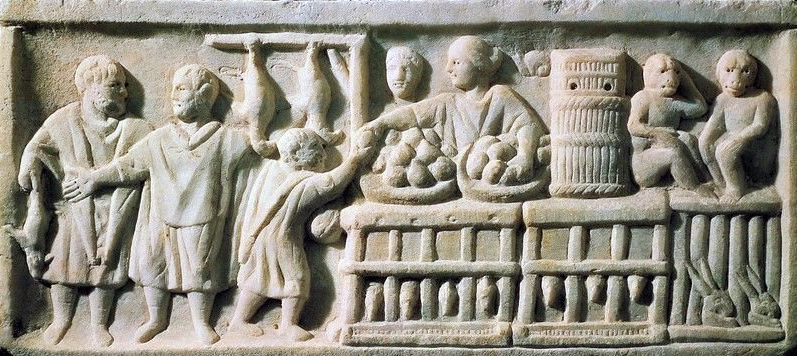
What is a taberna?
Originally a taberna was a one-room shop for the sale of goods or for services. They already existed in the Roman Empire before the republic. They were often part of a house, where the owner of the house sold the trade himself or rented the premises to third parties. Usually there were two tabernae on either side of the fauces (main entrance).
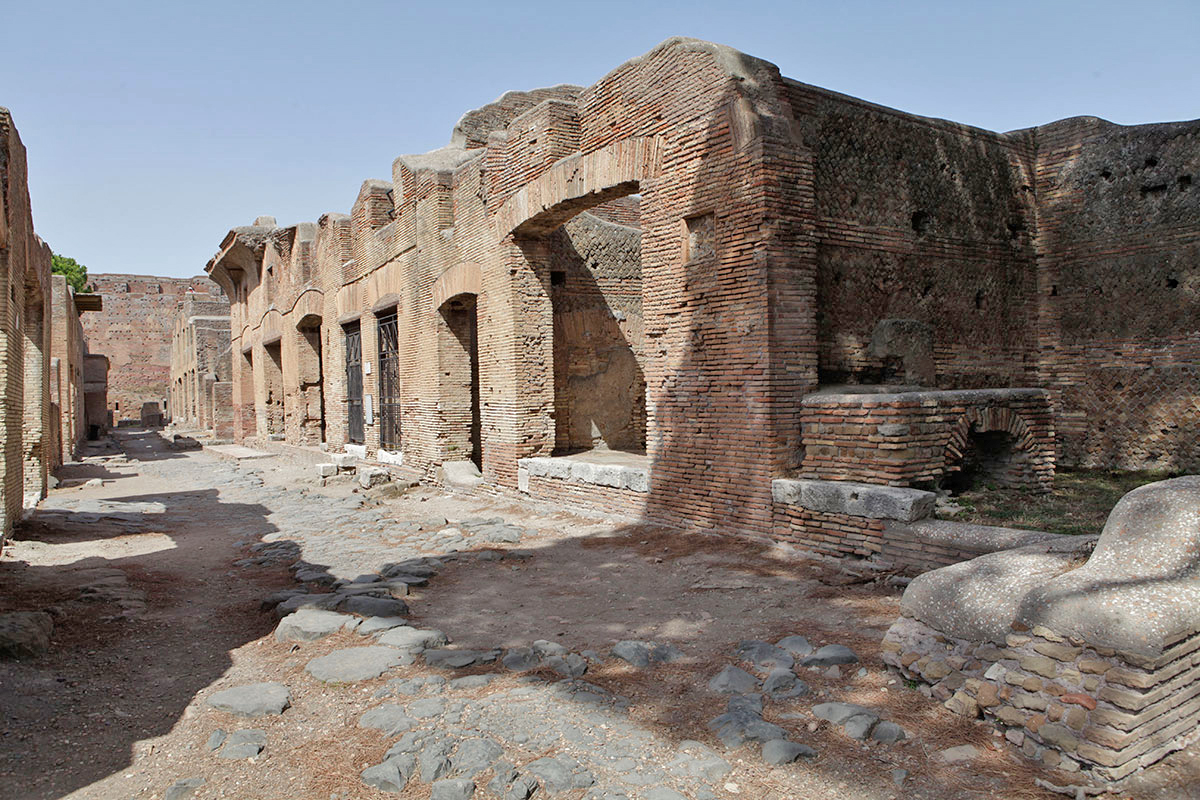
When the population expands sharply during the imperial period, private houses disappear and mainly insulae (residential blocks with several floors) appear, there is an increasing need for commercially exploited facilities. In the facades of insulae we see many tabernae on the ground floor and sometimes the entire ground floor is occupied by shops. These shops had a vaulted opening on the street side that took up almost the entire width and which could be closed in the evening with two wooden door partitions that were pushed in a groove in the threshold and locked.
Apparently, the taberna was merely a merchant's warehouse, a craftsman's workshop, or the sales area for a small merchant, but in one corner was often a small four- or five-step brick staircase leading to a wooden ladder. This ladder gave access to a half attic that was lighted through a small window in the centre above the door. This attic could be used for storage, but often the tenant of the taberna lived here with his family.
It has been said that in the case of a tenant who was in arrears with payment the ladder was removed by the landlord so that he was cut off from his source of income. The usual expression percludere inquilinum (closing a tenant) was in this case synonymous with forcing the tenant to pay.
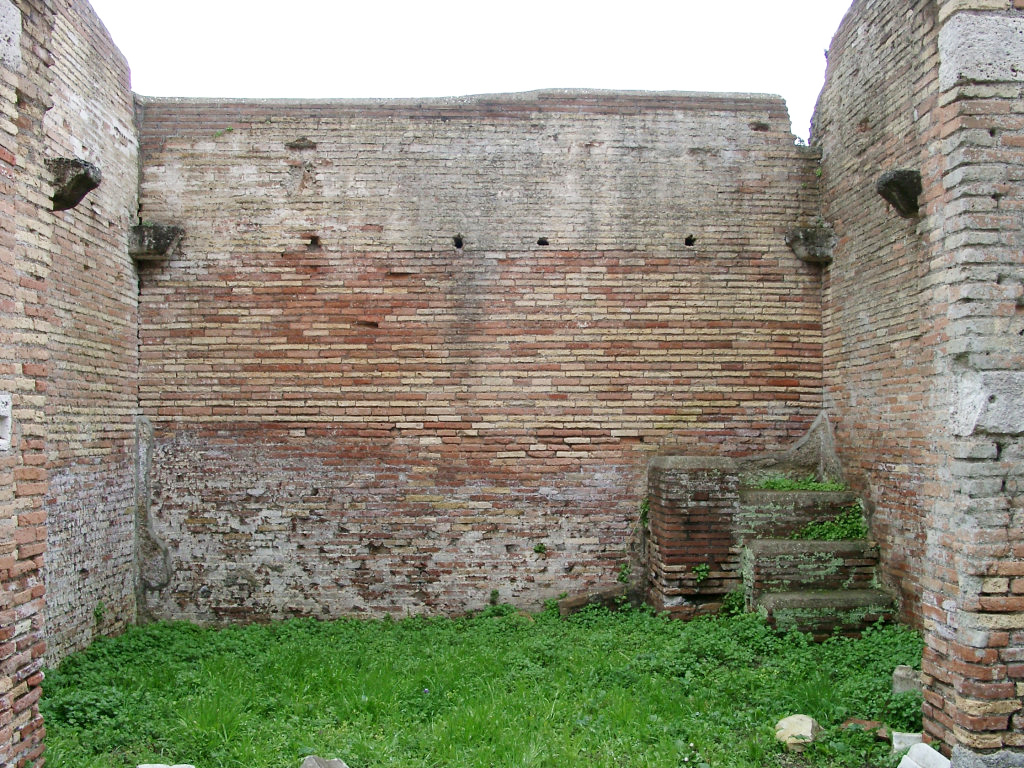
When the demand for commercial space increases even more, as we will see in the article below, buildings are also being built specifically for the creation of tabernae; long lines of shops along a street or even some sort of shopping center such as the Marcato Traiano in Rome or the Caseggiato del Larario (I, IX, 3) in Ostia (see photo 6).
The following article takes you along the western part of Ostia's great main street, the Decumanus Maximus. This runs from the Forum to the Porta Marina, the city gate on the sea side.
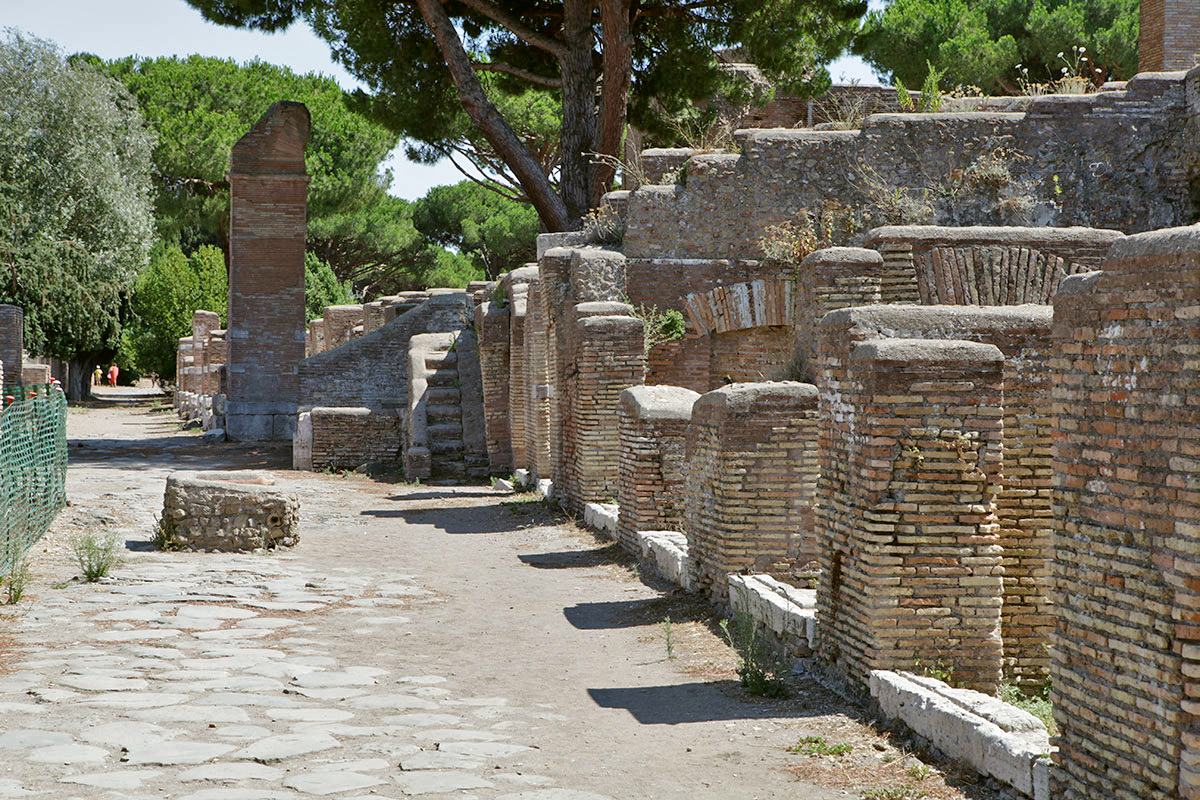
Tabernae and commercial investment along the western decumanus in Ostia
From a report by Miko Flohr
The streets of Roman cities were generally dotted with shops, and the public domain was mainly dominated by daily commerce. As negatively as some classical authors wrote about these local merchants and craftsmen, there is no doubt that, particularly because of their abundant presence, they set the mood of many a Roman city. This is also the case in Ostia, from the republic to the last person who left the city and closed the door for ever.
A key element in this commercial dominance was the taberna, a multi-functional commercial facility consisting of a large space with a wide entrance on the street side. Often there were one or two other rooms behind or above the main room.
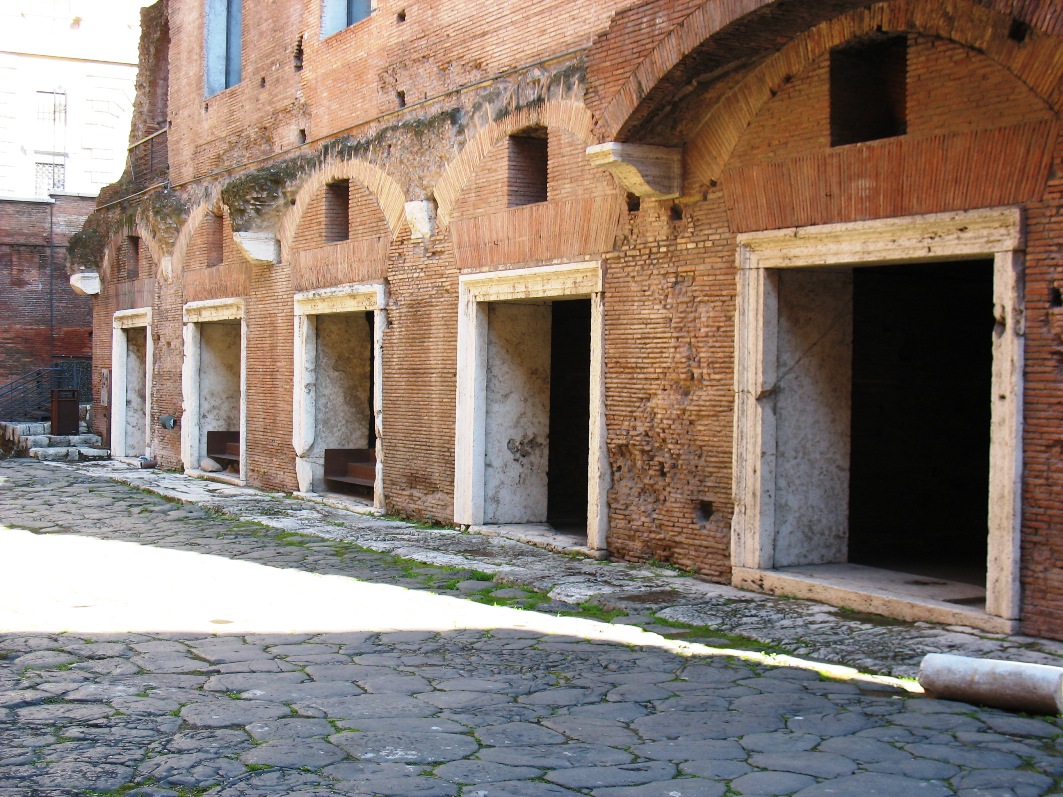
Various scientists have already researched this in recent decades.
Ray Laurence4 mapped out the shops present in Pompeii, showing that streets closer to the center of the city were more commercialized than the streets in more distant neighbourhoods and what kind of impact that had on the social landscape of Pompeii.
Janet DeLaine5 has made the same analysis for Ostia. She distinguished between the different types of commercial locations that played a role in the trade and retail trade and divided the tabernae into four basic categories:
- tabernae along the main roads;
- tabernae belonging to important public buildings;
- tabernae along secondary roads and dead ends that may or may not be closed off from the main roads:
- tabernae in purpose-built markets or bazaars.
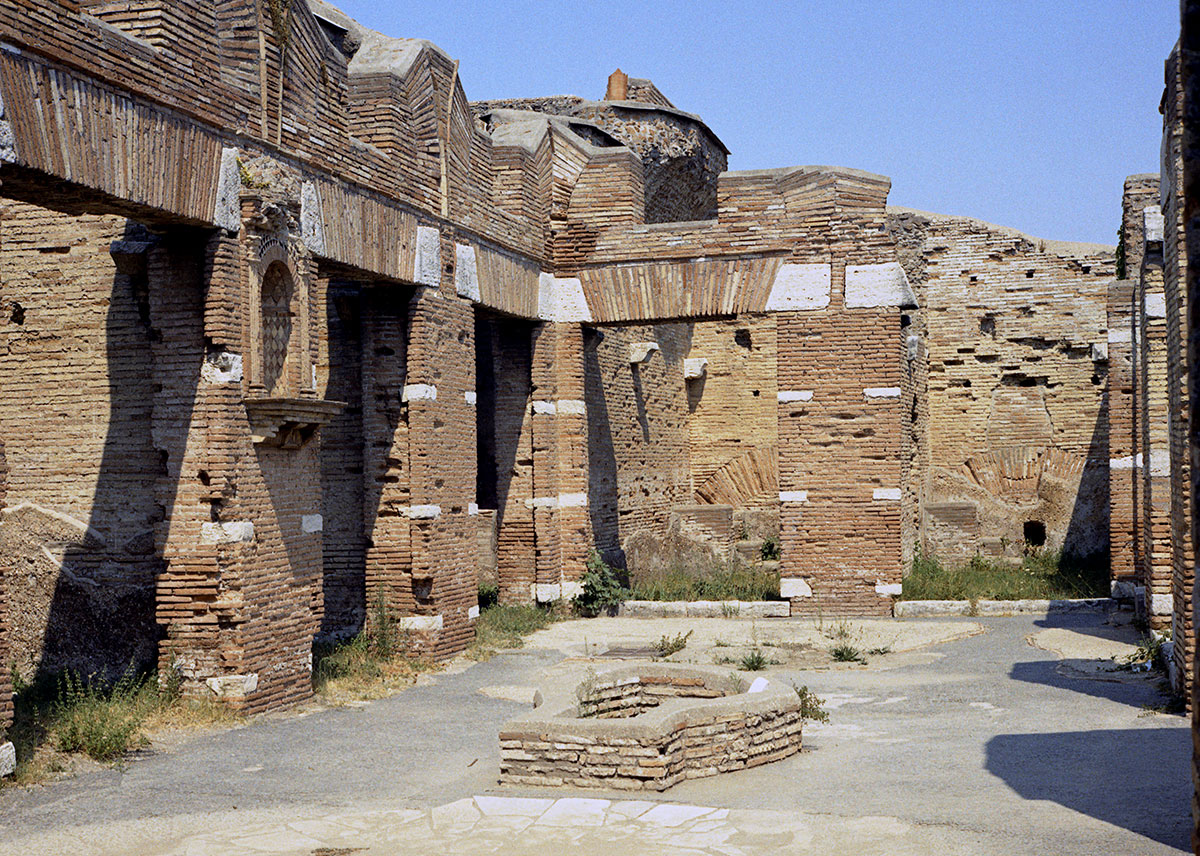
In addition to the occupancy rate, this subdivision also shows much better than in older analyzes what the nature of the tabernae was.
Both Laurence and DeLaine analysed the commercial landscape for a certain moment in time (for Pompeii 79 AD and for Ostia the second century6).
It becomes a completely different story when we try to analyse how that urban commercial landscape has developed throughout history and which people and decisions played a role in it. This will be quite difficult for Ostia, because a large part of the city of Ostia, especially outside the city wall, has not yet been excavated.
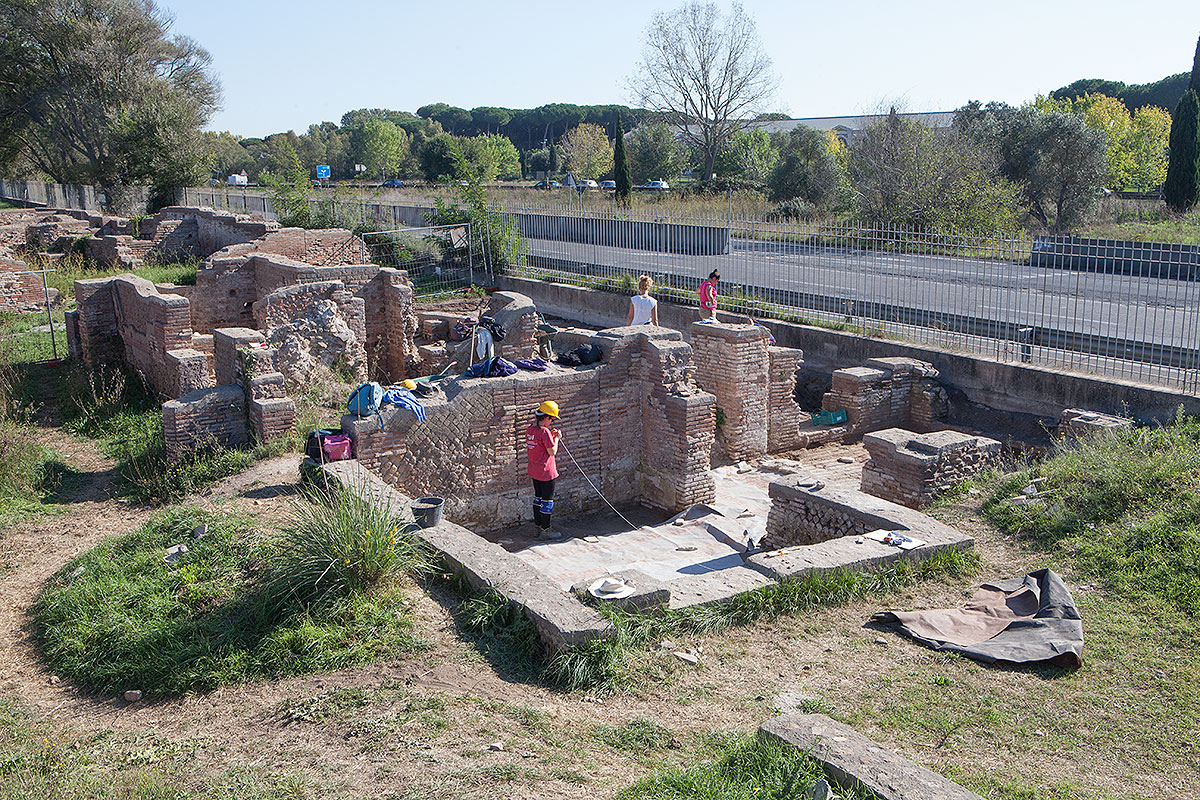
Still, the excavated part of the city is large enough to evoke a credible image. The most promising approach appears to be studying a specific set of neighbourhoods at micro level. That is why, for various reasons, the western part of the Decumanus in Ostia has been chosen.
One reason is that this stretch of road played an important role in the city's traffic system. In addition, the nature of the surrounding buildings plays a role as well as the fact that, through archaeological excavations below the current level, much is known about the history of this part of the city before the second century AD.
Before we focus on the western Decumanus itself, however, we would like to briefly sketch a general picture of how the commercial landscape in Ostia appears to have developed and what we know about it.
The big picture: commercial investment in Ostia
Because of Ostia's specific history, it is relatively easy to map out a pattern of businesses from the 2nd century AD, and, to a limited extent, later in time. It becomes more difficult if we want to do that for earlier periods. It often depends on the number of places archaeologists have excavated below Hadrian level and how far these results have ever been published. Still, some general observations can be made.
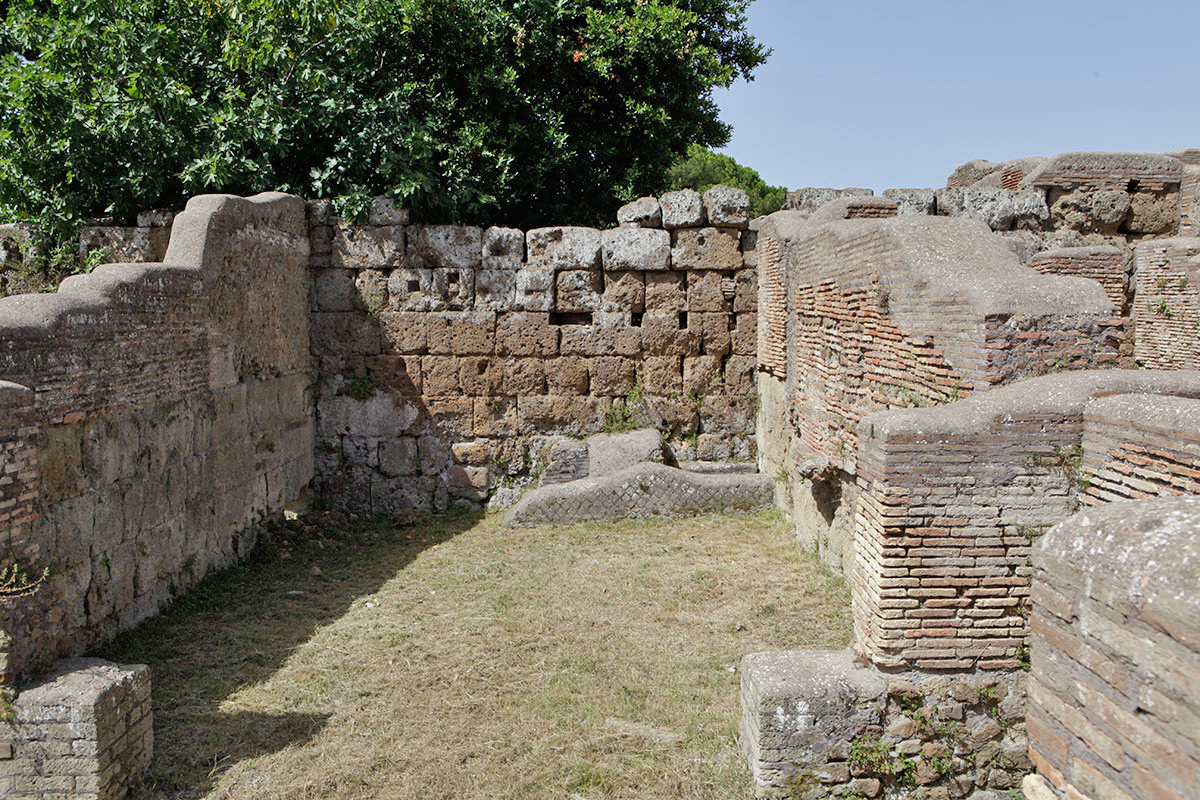
In the first place, we see, based on the current map of the city, that during the period that the city expanded slowly but steadily, i.e. before the major redevelopment of the 2nd century AD, the building plots issued to private individuals were deep but also relatively narrow. Therefore there was only room for a limited number of tabernae next to the entrance of the main building. The commercial activities were thus also limited. It is not entirely clear why that was, but it simply shows the socio-economic reality: there was clearly no need for long-façade commercial buildings, nor were there any people who needed or were able to build atrium houses from the size of the big city villas as we see them in Pompeii.
This pattern of building did pose problems for future investors who wanted more. It was hard enough to buy one house, two or three was almost impossible. Therefore, the property boundaries around the original castrum7 remained fairly stable during this period and private investment was very limited. This, of course, was different if the government was involved.
In addition, we also see that from the second century BC. large complexes with tabernae in Ostia existed. These complexes were especially visible in the early empire. Examples of this can be seen, for example, in the long row of at least ten tabernae at the location of the later built Horrea of Hortensius (early first century AD) along the eastern Decumanus (see photo 9).
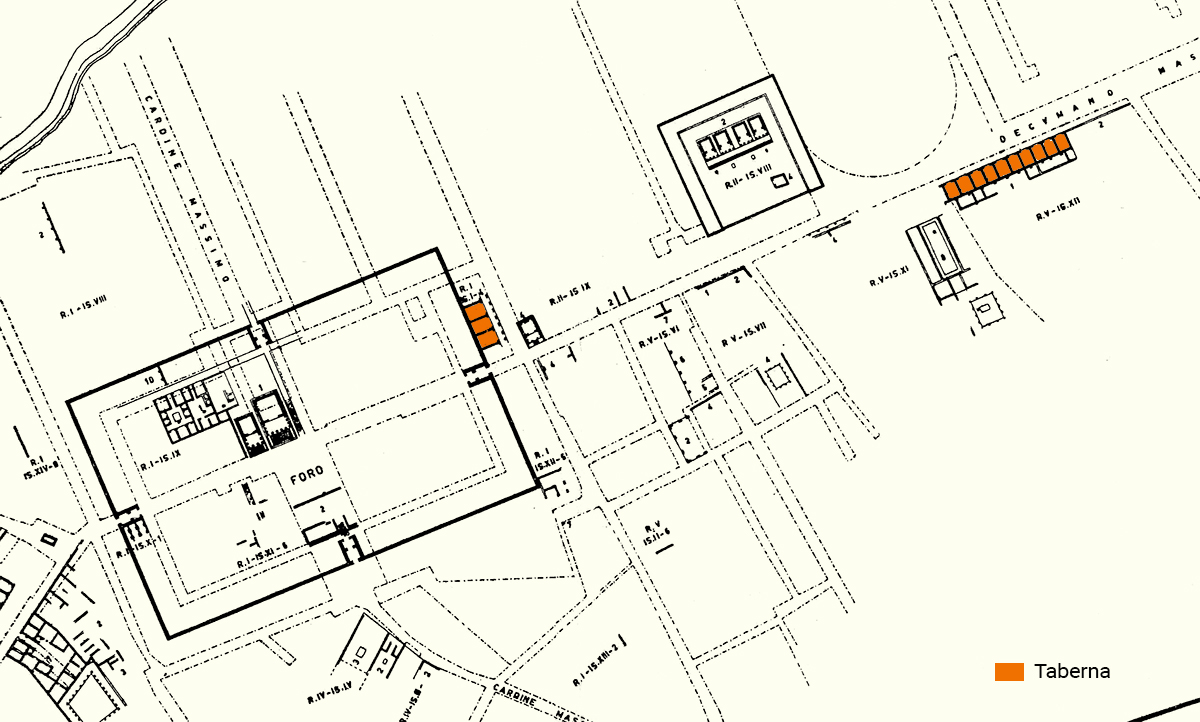
In the early first century, a row of tabernae was also built along the east wall of the castrum, probably by the government. So during the time before Hadrian we see private investments on a small scale and at the same time public buildings with long rows of tabernae. This picture differs remarkably from most other cities in Roman Italy.
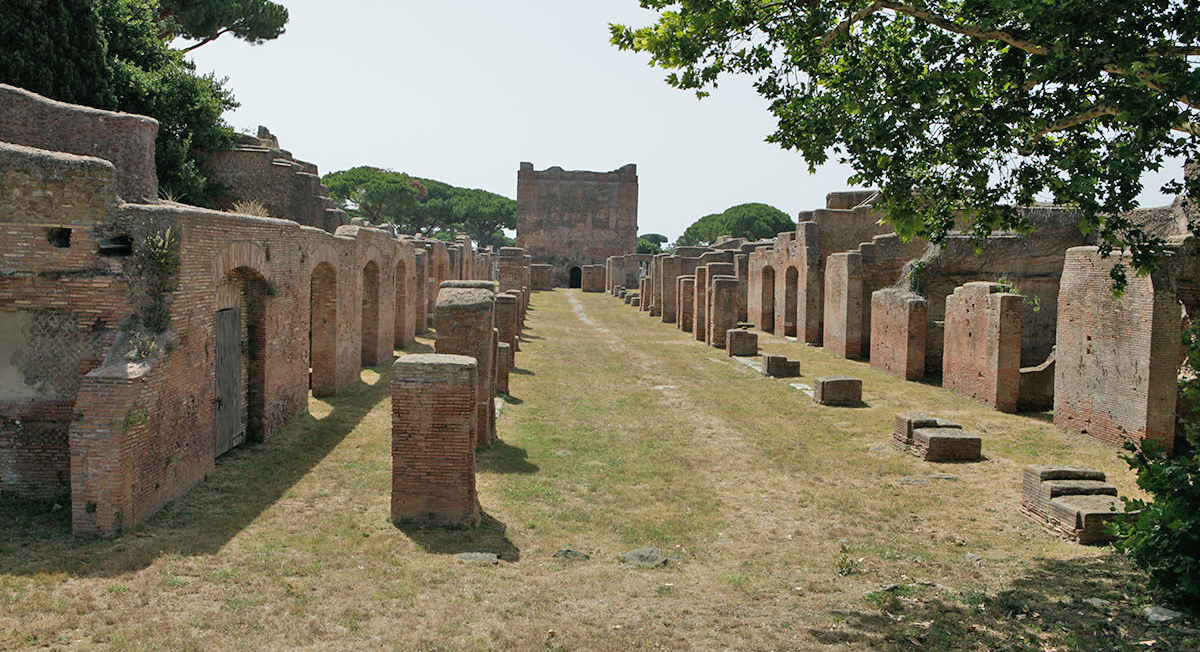
The major redesign in the second century AD. shows a development of building activity on an even larger scale, clearly at the initiative of the government. We see this spectacularly reflected in the development of the road between the Forum and the Tiber, and the portico of Pius IX that runs around it. But also at the bathhouse of Neptunes where we find a porticus with 24 shops along the eastern Decumanus and several around the palaestra and the streets within the complex.
On a smaller scale we see developments in the area of the former castrum, where excavations were carried out by G. Calza and G. Becatti below Hadrian's level. For example, Cassegiato I, VIII, 7, opposite the Caseggiato del Larario consists of three tabernae where previously were only two tabernae.
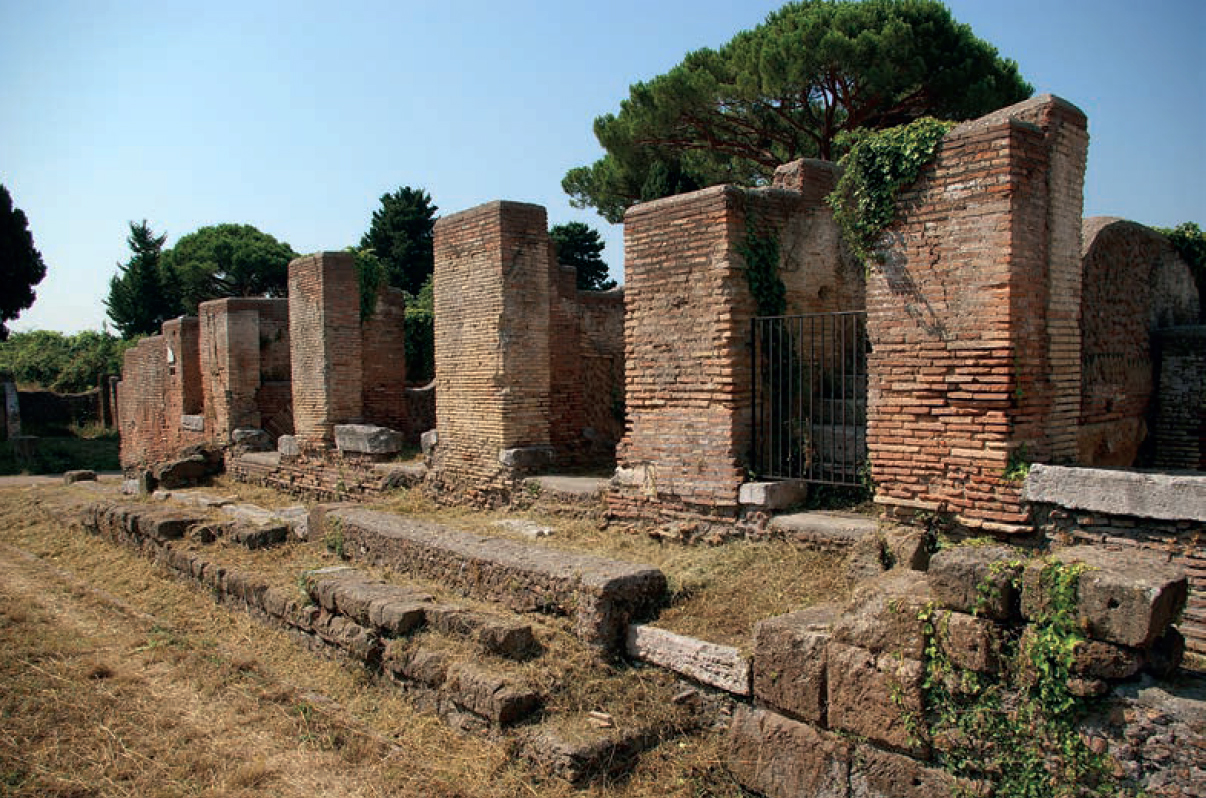
The so-called Casa Basilicale has 6 tabernae on the facade taking the place of 3 medium-small atrium houses, with probably two tabernae each. The number of tabernae thus remained the same, although the shopkeepers apparently had to deal with a different owner who operated on a larger scale. In other words: the spatial dynamics from before the second century AD. changed, the atrium houses disappeared and with it the traditional space occupied by houses. It seems that with the increase in construction activities, the number of shopkeepers working in tabernae that were part of a complex of shops also increased sharply. This can also be found along the western Decumanus.

The Western Decumanus
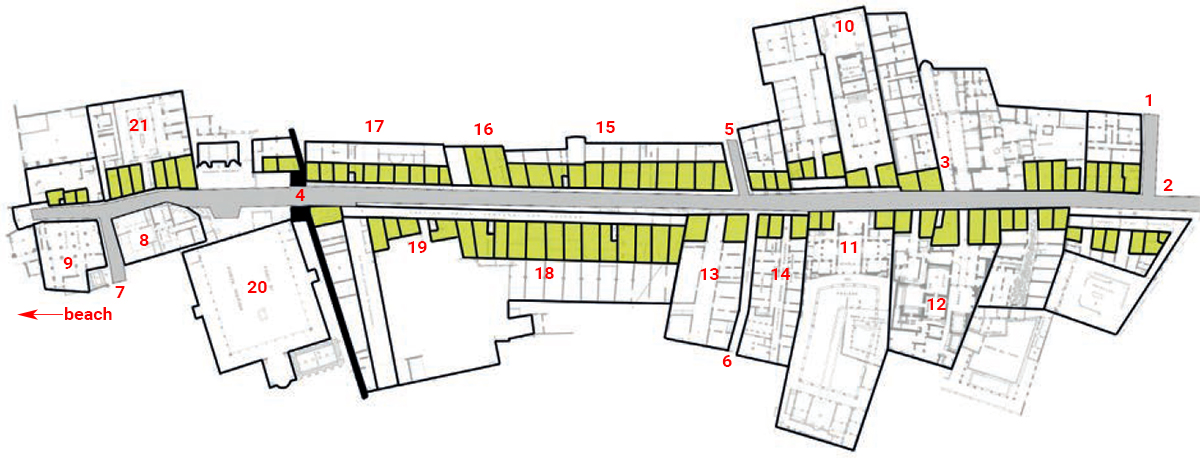
The western Decumanus, together with the eastern Decumanus and the Via delle Foce, occupies a central position within the urban road plan and commercial traffic. So a lot of money could be made along these roads by building retail facilities that could be rented out. As a result, between the Bivio del Castrum (2) and the Porta Marina (4) only one small part of the façade, at the level of the Basilica Cristiana (3), was closed until the late Antiquity.
If you look at the buildings around the Decumanus, the road can be divided into three sections. The first section runs from the Bivio del Castrum till the Via degli Aurighi (5) and the Vico Cieco (6), the second from Via degli Aurighi till the Porta Marina and the last from the Porta Marina to the beach where the Decumanus ceased, although traffic could continue south along the coastal road via a side road of the Decumanus between the Sanctuary of Bona Dea (8) and the Loggia of Cartilius Poplicola (9).
Let's take a look at the three sections.
From Bivio del Castrum to Via degli Aurighi
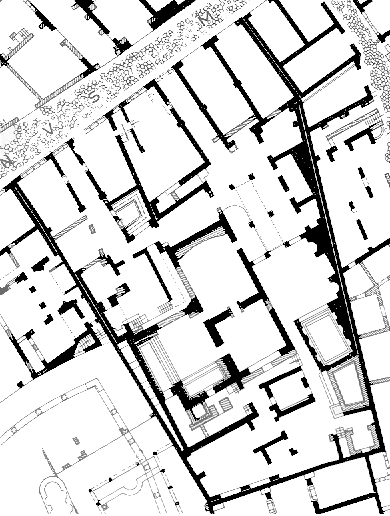
the Decumanus with two tabernae each.
The first section of the western Decumanus had a length of about 150 meters, with 21 tabernae on the south side8 and 20 on the north side. so there was relatively little room for tabernae on the street side. After the construction phase from the second century AD. there was an average of space here for 3 tabernae per plot.
On the south side, several parcels seem to have merged during Trajan or Hadrian.
The Schola del Traiano (11)9 is built on two older houses. The same goes for the Terme delle Sei Colonne (12).
Below the house to the right of this, the archaeologists Calza and Becatti identified a classic atrium-peristyle house from the time of the Roman republic. This was also the case for the house opposite the Via degli Aurighi, the Caseggiato delle Tabernae Finestrate (13).
The number of tabernae will not have varied much before and after the second century AD. What did differ, in addition to the merging of various plots, was the context. In the second century, the houses had disappeared in almost all plots, and so did the plot owners. The physical distance between the tenant of the taberna and the owner had increased and with it the social distance.
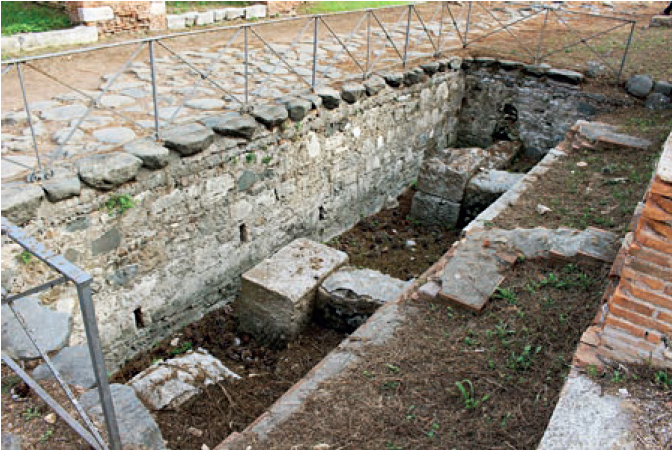
On the north side, the changes were less spectacular. Most of the buildings did not have a residential function and therefore no plots were merged. Both the building on the site of the Temple of the Fabri Navales (ship carpenters) (10) and its western neighbour are believed to have had the same number of tabernae before and after the second century. Although it must be said that, with the exception of the Fabri Navales, little research has been done in this area below the level of the second century AD.
From Via degli Aurighi to Porta Marina
The second part of the Decumanus shows a different picture, although it was about as busy with shops here. The second section is also 150 meters long and housed during the 2nd century AD. 24 tabernae on the north side and 18 along the south side. However, instead of being surrounded by buildings, the road here is surrounded on both sides by mere rows of tabernae.
While in the first section the situation seems to have developed this way only over time, in the second section there appears to be deliberate planning. Perhaps, because the need for more shops was already present at the time, the government issued special long parcels running parallel to the road. It may be, although not certain, that the government was the main investor in this area.
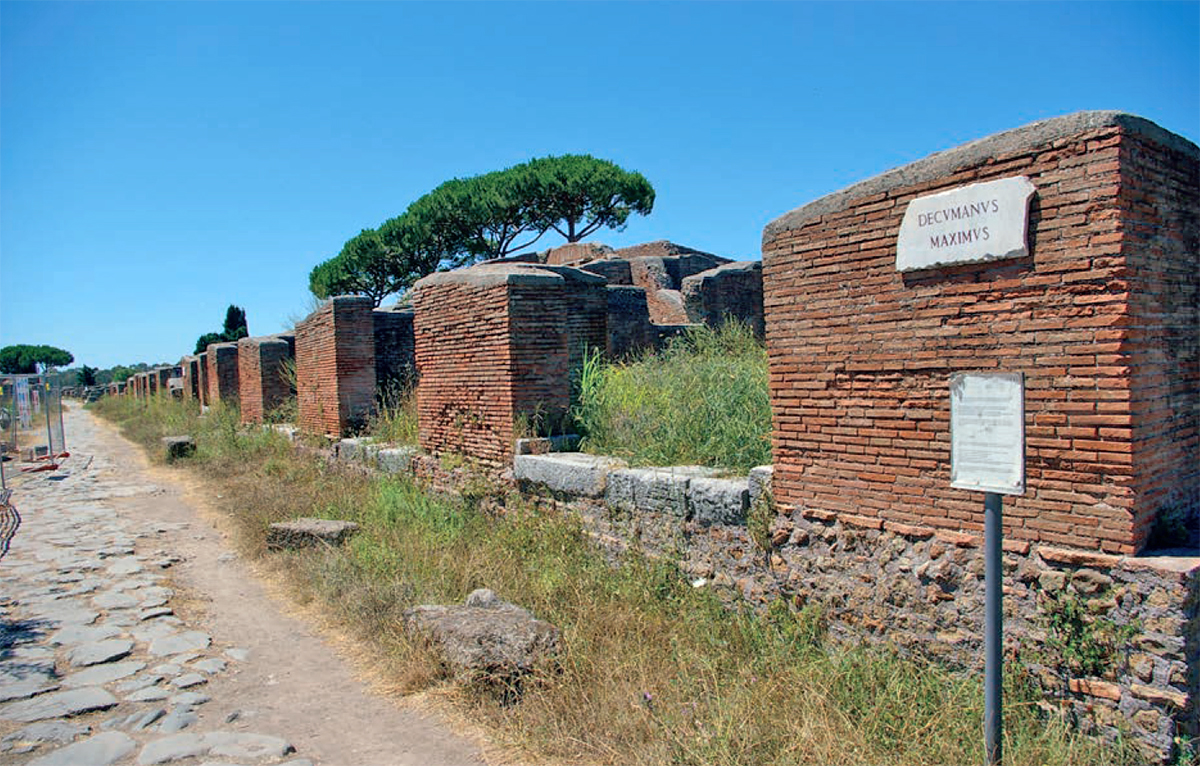
There are three separate buildings on the north side of which the Caseggiato delle Trifore (15) from the 2nd century AD. with 12 tabernae is the longest. Under the existing level, Calza10 and Becatti11 reconstructed the precursor from the time of Augustus: a row of 9 tabernae with a portico in front that occupied three quarters of the later building.
The other two buildings on the north side have respectively two and ten tabernae and are slightly older.
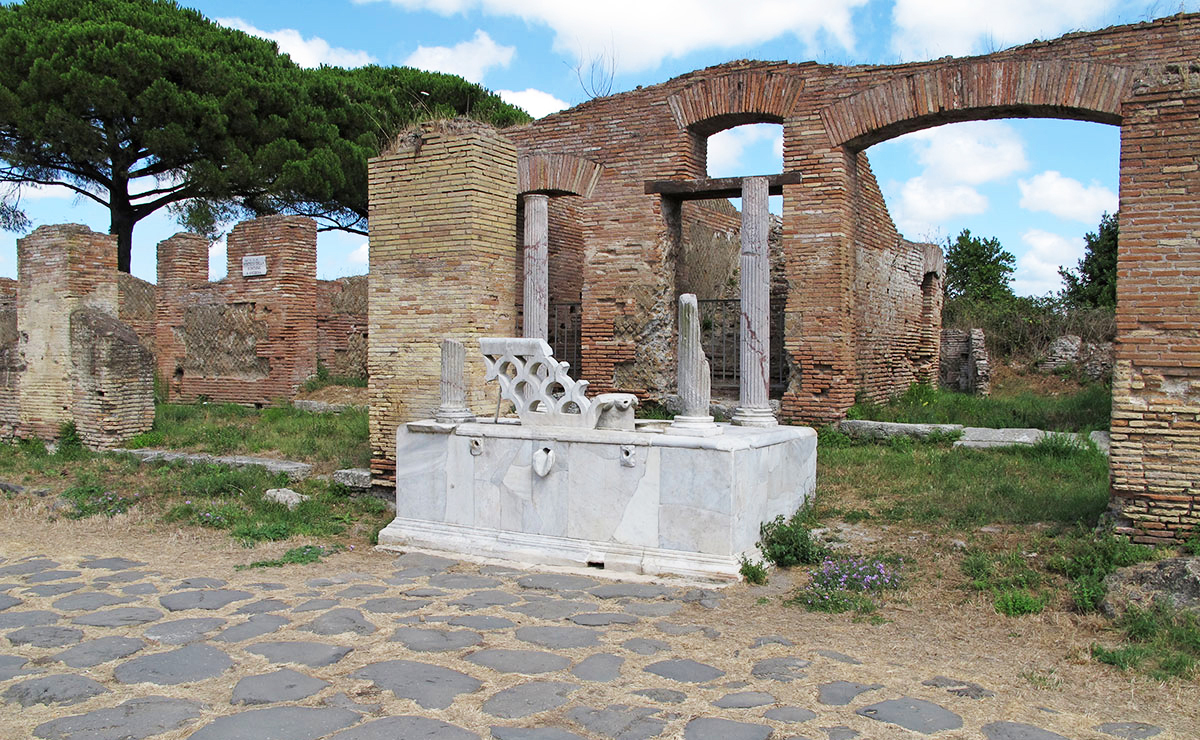
On the south side, the largest space is occupied by the Caseggiato della Fontana con Lucerna (18) with thirteen shops. These were dated by H. Bloch12 around 120 AD. A partially excavated building from the same period with four tabernae was connected to this complex.
With the exception of the Caseggiato delle Trifore, little of a chronological development can be seen in this segment. This could mean that this segment was developed at a relatively late stage and the demand for commercial activities in this area was low until the end of the reign of August. That is perhaps also the reason that both the Caseggiato delle Trifore and the Caseggiato della Fontana con lucerna have quite large tabernae. In addition, it may also be that larger and more luxurious tabernae were built on the south side of this segment to keep out certain types of trade. These shops were much more expensive to rent and more attractive for a more exclusive trade.
From the Porta Marina towards the beach
Outside the city gate (Porta Marina), construction was irregular and haphazard. There was also less economic activity in this part of the Decumanus.
This third section is 95 meters long and there were only 11 tabernae, all on the north side.
The south side was taken up by the Foro di Porta Marina (20) and the Santuario della Bona Dea. The latter goes back to at least the early first century AD, and its location suggests that a predecessor of the Foro di Porta Marina was already in place by then – making it unlikely that there ever were any tabernae in this area.
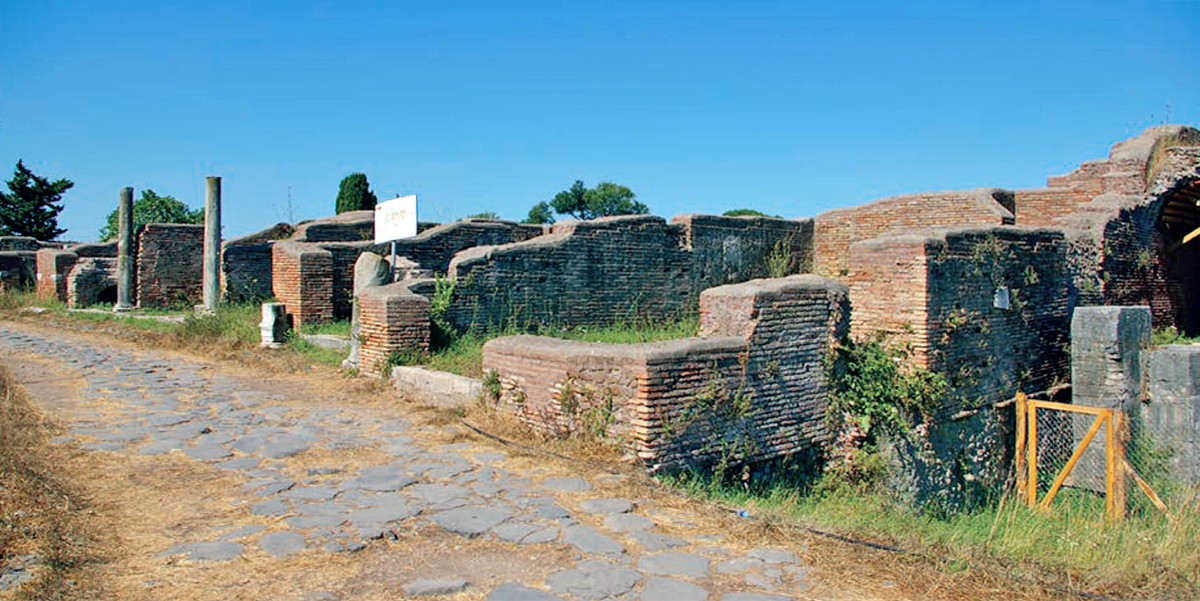
The shops on the north side were built from the middle of the first century AD. The first building was the Domus Fulminata (21) with its six tabernae from about 70 AD, followed by the building on the west side of the Domus Fulminata with three shops from the time of Trajan. Finally, the small building comes immediately after the gate with two shops from the time of Hadrian.
On the south side, there is the Loggia of Cartilius Poplicola from the time of Hadrian, which has been identified as a covered market, which again indicates an increasing commercialization of the last bit of Decumanus at the beginning of the second century AD.
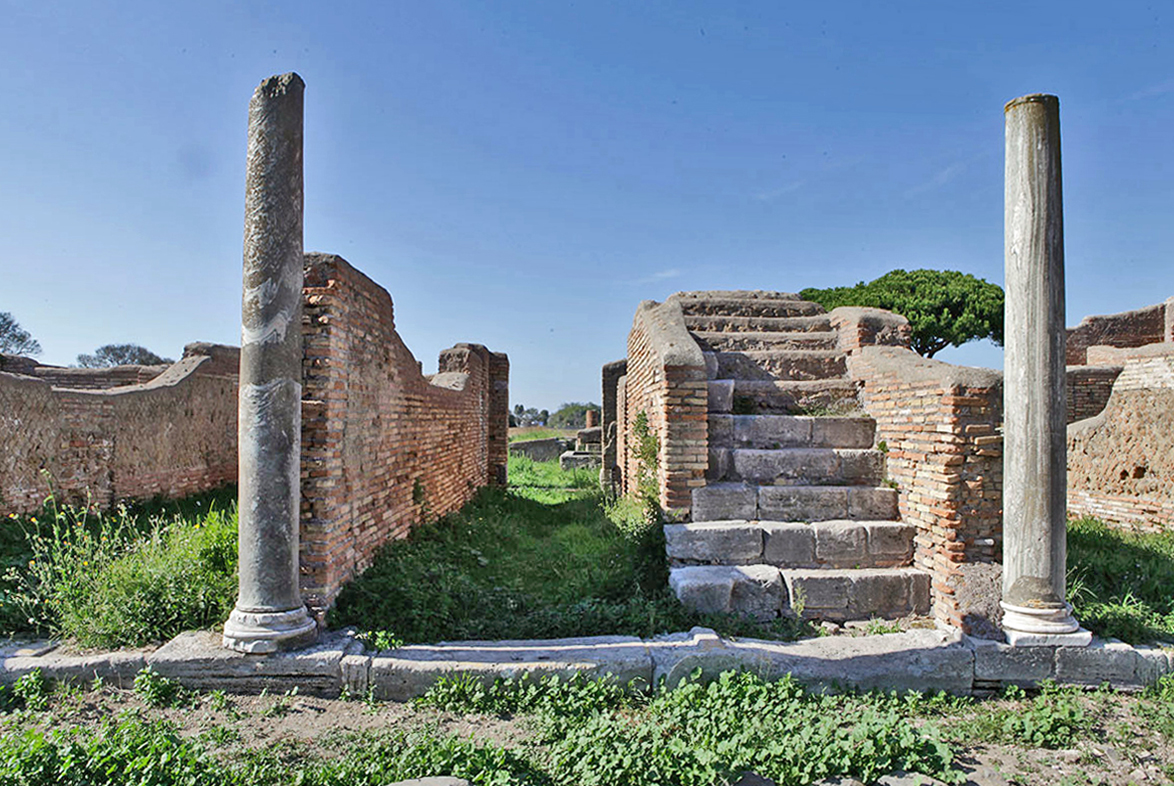
- Sources
- - Miko Flohr: Tabernae and commercial investment along the western decumanu in Ostia.
- - Jerome Carcopino: La vie quotidienne à Rome à l’epoque de L’Empire
- -www,ostia-antica.org
- Notes
- 1:Miko Flohr is an assistant professor at the Institute for History of the University of Leiden
- 2: A taberna (tabernae pl.) Is a space at the front of a domus or insula. These spaces facing the street were rented out to merchants or the owner of the house traded something himself.
- 3: Foto: www.ostia-antica.org (Daniel-González-Acuña)
- 4:Ray Laurens, Professor of Ancient History, Macquarie University (Australië)
- 5:Janet DeLaine, Associate Professor in Roman Archeaology at the University of Oxford and a fellow of Wolfson College.
- 6:Ostia suffered a lot from flooding of the Tiber every year. This fact and the explosively growing number of inhabitants prompted the government at the beginning of the second century AD. to decide to raise the city by about one and a half meters, to rearrange it (according to a rectangular plan) and to create space in height. Most of the low-rise buildings (villa, domus, etc.) had to disappear and 4 and 5 floors of insulae were placed instead. This redevelopment was led by Hadrian. That is why the beginning of the second century AD. was a turning point in architecture, use of materials, living and trade fot Ostia.
- 7:Ostia was founded as a walled camp, castrum. (see article "A harbour for Rome"). Various parts of the old walls can still be seen.
- 8:North and south are not the topographical indications but are used relatively here.
- 9:Read "The Collegium, the Roman Guild"
- 10: Guido Calza (April 21, 1888 – April 17, 1946 in Rome, Italy) was an Italian archaeologist Inspector of the great Ostia excavation campaign in 1938.
- 11: Giovanni Becatti (1912-1973) was an Italian classical art historian and archaeologist and staff member of the great Ostia excavation campaign in 1938.
- 12: Herbert Bloch (1911-2006). German archaeologist and historian. Staff member of the great Ostia excavation campaign in 1938.






 We are committed to providing versions of our articles and interviews in several languages, but our first language is English.
We are committed to providing versions of our articles and interviews in several languages, but our first language is English.